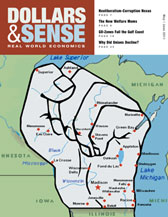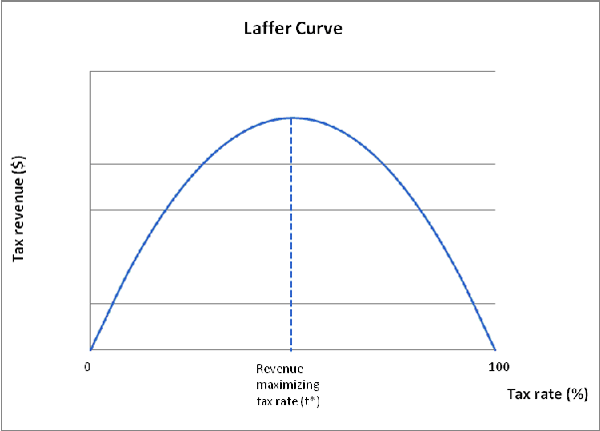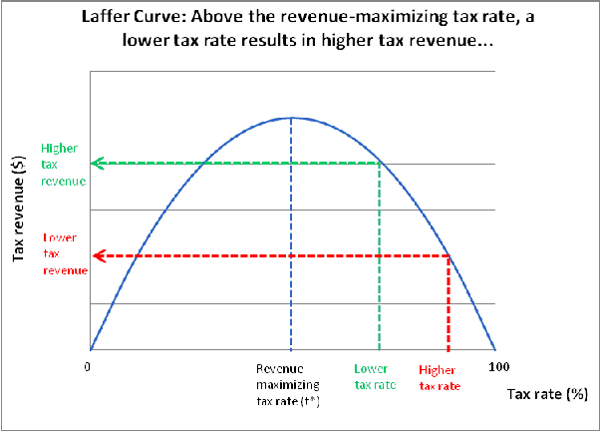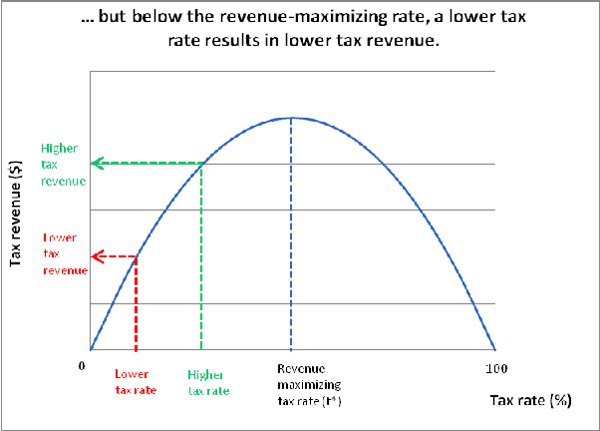This article is from Dollars & Sense: Real World Economics, available at http://www.dollarsandsense.org

This is a web-only article, available only at dollarsandsense.org.
Subscribe Now
at a 30% discount.

Do Lower Tax Rates Really Increase Government Revenue?
A co-worker of mine said that, when tax rates go down, the government actually collects more money from taxes? How is that even possible?
This is an old saw from a school of thought called “supply-side” economics. The supply-side economists, or “supply-siders,” were group of conservative economists influential with the Reagan administration. The term “supply-side” comes from their rejection of Keynesian economics’ emphasis on total demand to explain the total level of output (or GDP). The main issues, they argued, were on the supply side of the economy, especially the supply of labor and money capital (saving).
The supply-siders claimed that high marginal tax rates were a big disincentive for people to work, save, and invest. If tax rates were lower, and people got to keep more of their incomes from work or investments, this would create incentives to work more and to save and invest more. As a result, the supply-siders argued, the economy would grow faster. The government, they claimed, could get more tax revenue by taking a smaller slice (lower tax rate) from a larger pie (higher GDP).
The idea that lower tax rates could translate into higher total tax revenue is described by the “Laffer curve.” Legend has it that supply-side economist Arthur Laffer sketched the curve on a cocktail napkin at a Washington restaurant in 1974, showing it to then-Ford administration officials Donald Rumsfeld and Dick Cheney. At a tax rate of 0%, total tax revenue would, of course, be $0. At a tax rate of 100%, Laffer argued, it would also be $0, since the tax would kill all incentive for people to engage in the taxed activity. Therefore, he concluded, tax revenues would not keep rising with increasing tax rates. At some point, increasing tax rates would reduce total tax revenue—and diminishing tax rates would increase it.

You said that supply-siders emphasized “marginal” tax rates. What does that mean?
When we think of tax rates, especially income taxes, we usually think about the average rate we pay on all our income. Suppose you have an annual income of $51,000. If the tax rate on income up to $25,000 is 12.5%, the rate on income between $25,000 and $50,000 is 25%, and the rate on income above $50,000 is 82.5%, you will owe $10,200 in taxes. Your average tax rate will be 10,200 ÷ 51,000 = 20%. A “marginal” tax rate, on the other hand, is the rate you pay on your last dollar of income. Under the set of tax rates we just sketched out, at an income of $20,000, the marginal rate (the tax rate paid on that last dollar) is 12.5%. At an income of $30,000 it is 25%. At an income of more than $50,000, the marginal rate is 82.5%. If you had an annual income of $51,000, you would pay $825 out of that last $1000 in taxes.
The supply-siders believed that marginal tax rates were the key to understanding how taxes acted as disincentives to work and investment. The idea is that work and saving require some sacrifice. If you work for pay, you sacrifice free time and whatever you might have enjoyed doing with that time (leisure). If you save (in order to invest), you sacrifice present consumption and the enjoyment you would have gotten from that. They reasoned, on the basis of assumptions from mainstream “neoclassical” economics, that the sacrifice involved (for work or saving) increased with each additional unit. For example, it may not be much of a sacrifice to work a few hours each week, since you could just cut out the leisure activities that you least enjoy. Work some more hours, and you have to sacrifice activities that you enjoy more. Work a very large number of hours and you may have to sacrifice activities that mean a great deal to you. Likewise, if may not be much of a sacrifice to save a little income each month, since it may mean cutting back on things you don’t care about very much. To save a very large portion of your income, you may have to tighten your belt in ways that are pretty painful.
Neoclassical economists argue that people will make such sacrifices up to a break-even point—where the pain of the additional hour of work done, or the additional dollar saved, is equal to the reward—but no further. Supply-siders reasoned that high marginal taxes cut back on the rewards for making these sacrifices, so much that they were not worth making anymore. Cut those taxes, they argued, and people will work and save (and invest) more.
To really appreciate the supply-side argument, let’s look back at our numerical example. If you reason the way neoclassical economists think you do, you will compare the sacrifice required (say, in extra hours of work, or extra saving) each year to have an income of $51,000 instead of $50,000. But the reward is not really $1000, since you would have to pay 82.5% of it in taxes. It is really $1000 - $825 = $175. Would it be worth the trouble?
OK, I understand their point. But is the “Laffer curve” theory really true?
Let’s break it down.
The “hill” shape of the Laffer curve is based on three things:
First, if the tax rate were 0%, total tax revenue would be $0. That’s just math. If you multiply any number by 0, you get 0.
Second, at some positive tax rates, total tax revenue is positive. That’s common knowledge.
Third, if the tax rate were 100%, total tax revenue would be $0. Whether this proposition is true or not depends on a theory of human behavior. If people are engaged in an activity giving them some money income, and the government imposes a 100% tax (taking away all that income), will people continue to engage in that activity? If we think people will never engage in any activity unless they get some money income from it, then the answer is clearly no.
But people engage all the time in activities that generate no money income. For example, people raise children, and that is definitely not a money-making venture. One can easily account for this behavior if one thinks that people may gain satisfaction (or, in econo-speak, “utility”) from something other than money — for example, intrinsic enjoyment, altruism, duty, etc. (Mainstream economics, far from excluding non-monetary motives, routinely includes at least some such motives in its behavioral models.)
If people are willing to engage in some activities even though there is no financial “return,” however, this means they may be willing to engage in an activity beyond the point where a 100% marginal rate applies. The financial return may be taken away by the tax, but if there is some non-monetary reward associated with the activity, people may still have a motive to engage in it. If this is the case, then even a marginal tax rate of 100% (at least on some activities) may generate positive revenue.
For the rest of the discussion, however, we can go ahead and assume that a 100% tax will result in zero tax revenue. (This will allow us to consider some other critiques of the Laffer curve and supply-side economics in general.) In that case, we have a curve that starts at 0 (for a tax rate of 0%), rises and then falls over a range of positive amounts (for tax rates between 0% and 100%), and ends at zero again (for a tax rate of 100%)—as the Laffer curve does.
If the Laffer curve is accurate, how exactly does that relate to the idea that higher tax rates result in lower total revenue and lower tax rates result in higher total revenue?
According to the supply-siders’ own theory, increasing the tax rate does not always reduce tax revenue, nor does decreasing the tax rate always increase tax revenue. It all depends on whether the current tax rate is above or below the tax rate where tax revenue reaches a peak (the “revenue-maximizing” rate).
If the tax rate is already above the revenue-maximizing rate (labeled t* on our graphs), an increase in the tax rate will reduce total revenue. A decrease in the tax rate, meanwhile, will increase total revenue, so long as the new tax rate is still above t*. (If the new tax rate is below t*, then we cannot say for sure whether total tax revenue will increase or decrease.)
On the other hand, if we start out with a tax rate below t*, a decrease in the tax rate will decrease total revenue. An increase in the tax rate, meanwhile, will increase total tax revenue, so long as the new tax rate is still below t*. (If the new tax rate is above t*, then we cannot say for sure whether total tax revenue will increase or decrease.)
To make the supply-side case, one would have to prove that a tax rate was already above the revenue-maximizing rate.


Well, is there historical evidence that shows whether marginal tax rates are too high? I know some people say that the Reagan tax cuts ended up increasing tax revenue. Is that true?
First, we can’t just go and look at tax revenue data for the year or two after a change in tax rates and think that’s going to tell us the answer. Whether tax revenue went up or down in the years after the Reagan tax cuts, we would not know if the tax cuts were the cause or not, since many other things were changing at the same time. In fact, total federal tax revenue was lower in 1981 and 1982 than in 1980, but the U.S. economy was also in a severe recession. (When the economy is in a recession, incomes decrease and so do tax revenues.) By 1983, with the economy in a recovery and incomes increasing again, federal tax revenue recovered to a little more than the 1980 level, and continued to grow for the rest of the decade.
The recession was triggered, at least in part, by very high interest rates. (This is altogether separate from tax rates.) The U.S. Federal Reserve (aka, “The Fed”), which makes decisions affecting the money supply and interest rates, deliberately adopted a “tight-money” (high interest-rate) policy to combat spiraling wages and prices. Higher interest rates rein in demand, by making it more expensive for firms and consumers to borrow and spend. In this case, the sharp decline in demand triggered a deep recession and massive unemployment. As GDP declined and unemployment soared, however, the Fed reversed this policy. Lower interest rates stimulated spending, and helped bring about a recovery. Did the tax cuts also contribute to the recovery? Perhaps, but it may not have been for the reasons the supply-siders thought. With more after tax-income, people may have been inclined to spend more, increasing demand and stimulating increased production. In other words, the effect may have been on demand side (as Keynesians argue), rather than on the supply side.
If we look at the historical evidence more broadly, there doesn’t seem to be much evidence that high marginal tax rates mean slow economic growth, or that low marginal tax rates mean fast growth. In fact, between the 1950s and early 1960s, the top marginal income-tax rates were much higher that they have ever been since. (They were cut dramatically by the Kennedy administration, so the top marginal rates were already much reduced by the time of the Reagan tax cuts.) Those decades, however, saw high rates of economic growth, along with low unemployment and low inflation.
If lower marginal tax rates don’t lead to more work and investment and faster growth, why not?
Remember, the supply-side argument was based on assumptions about how people make decisions: for example, that they calculate the number of hours they will work in order to achieve some kind of maximum overall benefit. This requires that they make “marginal” decisions (for example, weighing the benefit an extra bit of income to the burden of an extra bit of work). This may not describe the ways people make decisions about, say, work hours.
First, many people may not be able to fine-tune the number of hours they work very easily. For example, someone in a regular full-time job may not have much flexibility on hours. They may not be able to choose to work, say, 37 hours (for less pay) or 42 hours (for more pay), even if that would suit them better than the usual 40 hours. Another way of increasing work hours, picking up an additional part-time job, may not be convenient. The minimum number of additional hours, for example, may be too large. Just because someone wants to work more than 40 hours a week doesn’t mean they will be happier working, say, a total of 60 hours at two jobs. For someone who would like to work fewer than 40 hours, switching to part-time may not be practical, either. This might involve too big of a decline in hours—say, down to 20 per week. Moreover, they may not be able to get a part-time job, in their occupation, at comparable hourly pay (or with needed benefits).
Second, many people just may not think in terms of “marginal” effects, even if they could fine-tune their work hours if they wanted. Many people may never calculate how much extra income they will take home for each extra hour of work. They may not think about their effective pay rate as changing with each extra hour (due to the change in the marginal tax rate as their income from work increases). They might not ever compare the extra income from, say, working 41 hours instead of 40, against the extra burdens of an additional hour of work. Instead, when they think about how much they work and how much they are paid, they may think about other things, like their total annual income (before or after taxes), or their total income compared to their total hours of work. They may compare what they make to what they made at some point in the past, to what co-workers make, or to what they might make at a different company or in a different occupation. These considerations may not have much to do with the sort of “optimizing” calculations that mainstream economic models assume people make.
Third, if people get accustomed to a certain income and certain material standard of living (perhaps with the expectation of gradual increases with increased experience, seniority, and rank) they may make decisions about how much to work primarily in terms of hitting their income “target.” This is especially true if a large part of their spending is “non-discretionary.” That is, most of their income goes to spending they can’t easily avoid (e.g., rent or mortgage payments, car payments, utility bills, insurance premiums, tuition, etc.). In that case, an increase in tax rates (on income from work) could actually increase work hours. If tax rates increase, and now people cannot make as much as they are accustomed in the same work hours, they might have to increase their work hours to make ends meet.
For all these reasons, work hours may not respond to changes in tax rates in the way that supply-side economists assume.
This undermines the supply-side story. The effect of a change in tax rates on total tax revenue depends on the relative strength of two opposing effects—how much tax rates decrease (which means the government takes a smaller share of the economic “pie”) and how much the decrease in tax rates causes incomes to increase (causes the economic pie to grow). If a change in tax rate has little effect on work (and investment) decisions and, therefore, does not have much of an effect on GDP (the size of the pie), it is unlikely to increase tax revenue.
Are the supply-siders just mistaken, then, or is there more to it?
There’s more to it.
For people who would favor tax cuts anyway, the Laffer curve offers an appealing argument—we can have a tax (rate) cut, but get increased tax revenue, and so not have to sacrifice any of the things we want from government. (That is, we can have our cake and eat it, too.) If true, this takes away one of the main reasons to oppose tax cuts—that they will require painful sacrifices of needed public programs. This argument, however, runs counter to other reasons people may favor tax cuts.
First, any particular tax cut is likely to benefit some people more than others. If tax cuts result in reduced tax revenue, as they certainly can, they may result in cuts in government programs. The programs cut might have benefited a different group of people. In that case, the combination of tax cuts and spending cuts will have helped one group and harmed another. Some people may just favor tax cuts that benefit themselves and people like them, while coming at the expense of someone else. Critics have argued, for example, that Reagan- and Bush-era tax and spending policies cut taxes mostly for corporations and affluent individuals, while mostly cutting programs that benefit lower-income people.
Second, proponents of “small” government may actually want to reduce government revenue. Some conservative strategists have argued in favor of tax cuts precisely to reduce government revenue and ultimately force spending cuts (to balance the budget). This is sometimes known as the “starve-the-beast” strategy. Notice that this strategy requires that tax (rate) cuts result in lower government revenue, the opposite of the supply-siders’ argument.
If you follow budget debates carefully, you will sometimes hear the same politician, in effect, making opposing arguments. When arguing in favor of tax (rate) cuts, a politician may make the supply-side claim that government revenues will increase as a result. When arguing against new or expanded government programs, however, they may argue that the new spending will require tax (rate) increases.
If they really believe the supply-side story, they should be arguing that increased government programs will require tax cuts, in order to increase tax revenues.
Did you find this article useful? Please consider supporting our work by donating or subscribing.
